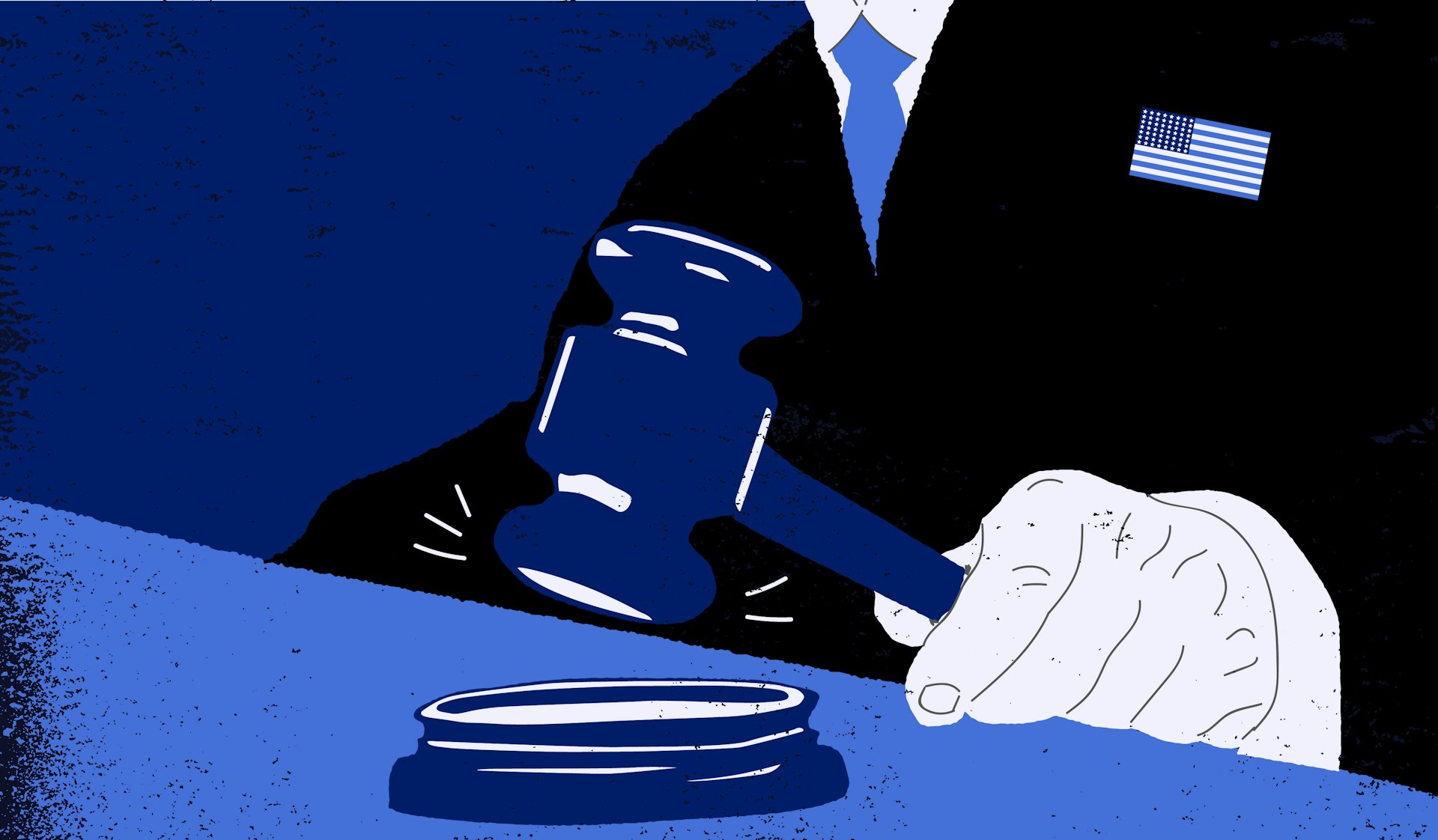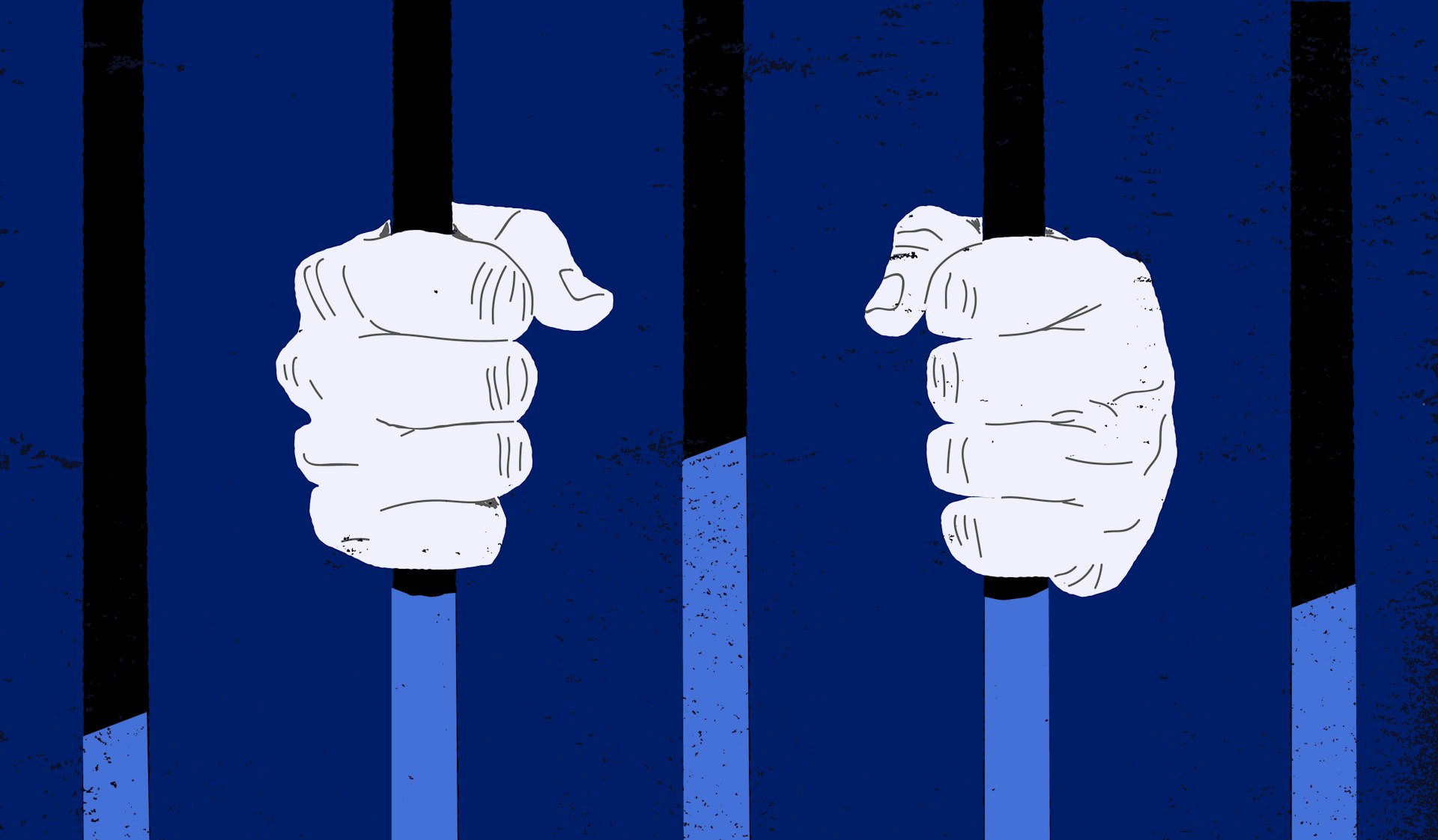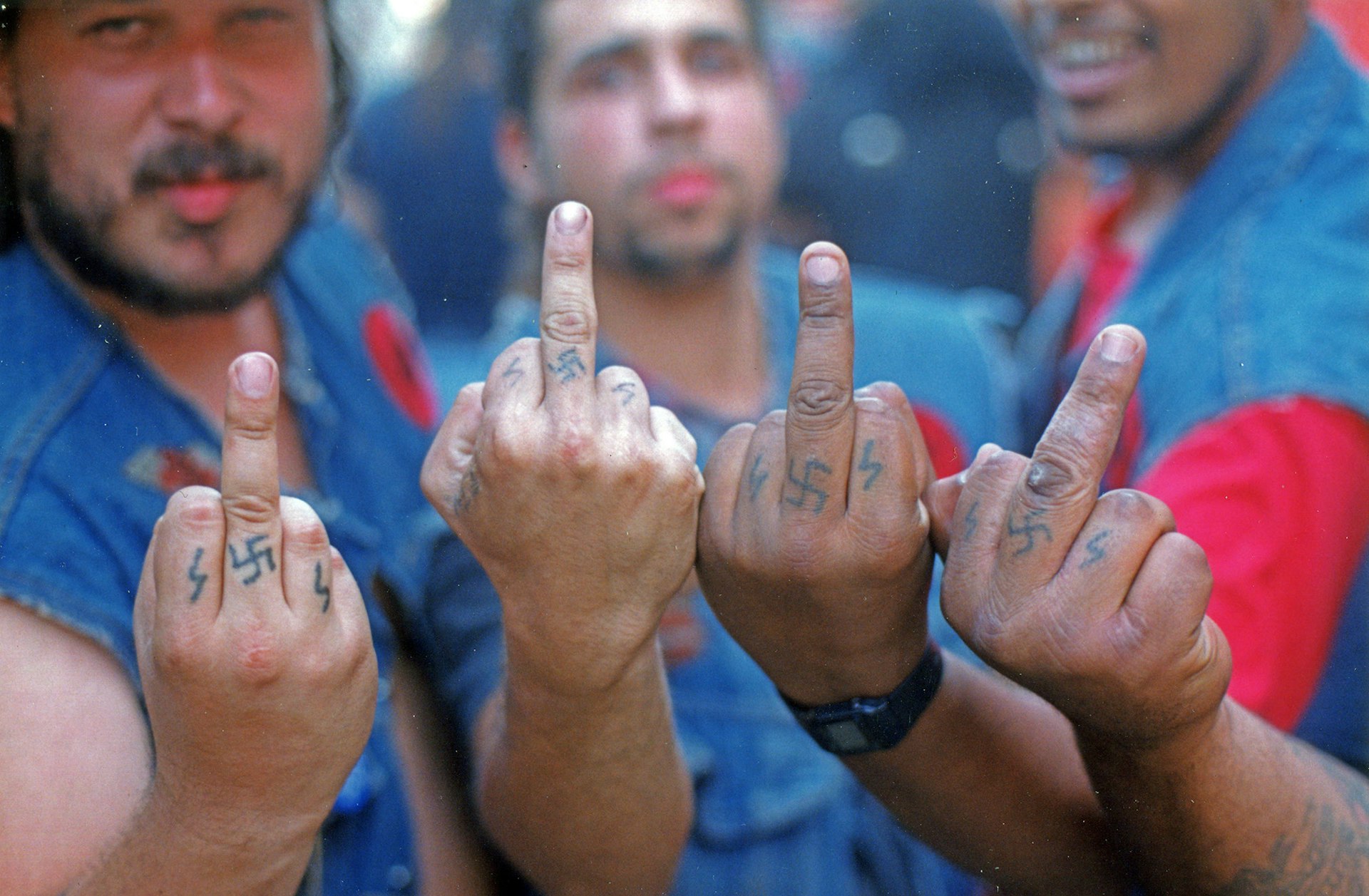
The Philadelphia Five: Young lives wasted by the U.S. justice system
- Text by Jeffrey Anderson
- Illustrations by Lucia Lopez
Delma Vazquez pulls away from the curb outside the brick townhouse where she grew up in North Philadelphia’s West Kensington neighbourhood. She braces for another of the hundreds of five-hour drives she has taken since her brother was sentenced as a juvenile to life in prison in 1991.
Riding shotgun on this November day is family friend Edwin Desamour, who along with her brother, James Oscar “Bebe” Martinez, was convicted and sentenced to prison for the brutal murder in May 1989 of the son of a police officer in the Irish and Polish neighbourhood of Port Richmond.
What began that spring day in 1989 as youthful retaliation made headlines — if not careers — in Philadelphia, where the media feasted on it as a racially-motivated attack on an innocent white youth by a gang of Puerto Rican thugs. When it was over, Bebe was one of two juveniles sentenced to life in prison without parole.
While the painful memories of that trial still exist, Delma is focused today on her brother’s physical and mental state, which has steeply declined behind the razor-wired walls of State Correctional Institution at Dallas, PA. Specifically, she is concerned that Bebe — all of 5-feet-1 inches and 142 pounds — had been a model inmate for more than two decades, until 2014, when a series of seizures and medical mishaps put him in a coma. He has had behavioural problems, and been in constant conflict with prison and medical staff ever since.
“When was the last time you saw him?” Delma asks. “Before he got sick?” Edwin nods. “He’s not the same,” says Delma. “You should have seen him in the infirmary. He was like a nine-year-old. You lost a friend. I feel like I lost my brother.”
They drive for hours through coal mine-scarred Northeast Pennsylvania, often silent, sometimes sharing memories of their old neighbourhood; and of Bebe, when he was doing his time and staying positive behind bars, working in a garment shop, playing on the traveling softball team, volunteering with hospice.
Delma laments that she cannot gain access to her brother’s medical records to find out what is wrong with him. Their phone calls have devolved into Bebe going on barely comprehensible, one-way rants. “I’m his sister, but sometimes I don’t want to pick up the phone,” she says, fighting tears.
Delma navigates the winding, mountainous roads that lead to SCI-Dallas, where mobile phone service drops alongside the temperature. At the prison, she and Edwin surrender their possessions, and after a short wait are waved through a locked gate, down a grim corridor, through another locked gate, and into a group visiting area.
After a longer wait, Bebe finally passes through a different locked gate in a maroon jumpsuit that hangs off his scrawny frame, now down to 129 pounds. His hair, greying and thin, is slicked back and short. He is upbeat at first, but over the next three hours, as he works on some vending machine food, he vacillates between playfulness and despair, rambling in a low scratchy voice about injustices that are hard to decipher.
He appears to ignore a group of inmates who form a semi-circle around a fellow inmate near the microwave not 30 feet away, while a female visitor performs oral sex. “Why am I on so many meds?” he asks, as the visit winds down, in reference to the regimen of Dilantin, Haldol, Klonopin, Valium and Zoloft he has scribbled on a sheet of notebook paper.
***
Sean Daily was not supposed to die on the fateful night of 20 May, 1989. The facts as stated in a Philadelphia Superior Court file are that a week earlier, a Hispanic youth named Rafael Droz was harassed and punched by a black teenager who was running with a group of white teenagers in Port Richmond. Vowing to return with his “Northside posse,” Droz, along with Edwin, Bebe and seven other youths, did just that — in a four-car caravan, some of them armed with bats and screwdrivers — and chased the teenagers who had assaulted Droz.

Sean Daily was with a friend, and having nothing to do with precipitating event, stood his ground, as two of Bebe’s associates descended upon him and broke his leg in two places. According to statements made to the police by his co-defendants, Bebe tried to shoot Daily, but the purported gun would not fire. Said gun was never recovered. There is little dispute that another youth produced a gun and actually did shoot Daily, who later died at the hospital.
The killing erupted in the press, which stoked racial anger and calls for swift justice. Police rounded up dozens of Hispanic youths in an effort to identify anyone who was in sight that night. After investigators obtained confessions from three of the youths, prosecutors tried the rest in a single trial, using information they gathered from the confessions. The trial, before Judge Lynne Abraham, lasted three weeks.
“It was a sensationalised, particularly gruesome incident,” says a former assistant District Attorney familiar with the case. “The reaction was, ‘We’re gonna get everyone who was involved and sort ‘em out later.’ There was some collateral damage with people who got caught up in it, and their families thought the system would straighten it out.”
One of the young men who cannot be named, an immigrant from El Salvador, climbed into one of the cars that night, despite not even knowing some of the youths in the caravan. He denies taking part in the fatal assault. “I was 17, I didn’t know my rights,” he explains, a father and a school teacher, on the phone from San Salvador, where he was deported after serving nine years in prison. “The thing is they didn’t let some of these kids see a lawyer right away, and they got confessions that they used against us, and then tried everyone at the same time. These guys could tell you what they remember with the cops. I hold no grudge. I’ve moved on.”
Enrique Lozada was also rounded up, incarcerated, but then released, when authorities conceded that he had not been present at the scene. “I did a whole year before they figured out it was mistaken identity,” says Lozada, who believes, as many do, that the police, then-District Attorney Ronald Castillo, and even Abraham were determined to dish out hard justice for political reasons.
“They went and arrested any Puerto Rican they could find. I didn’t have a lawyer present. They tried to beat a confession out of me. I still have the bloody clothes. Someone got killed, and my heart goes out, but you’re trying to beat confessions out of a 16-year-old chained to a steel chair? I’m still angry about it.”
Castillo did in fact run for mayor in 1991. He lost. But he was elected in 1993 to the Supreme Court of Pennsylvania, where he sat for 20 years, six of them as Chief Justice. Abraham, in turn, ran successfully for District Attorney, also in 1991. She served for nearly 20 years, earning a ranking just last month from the Fair Punishment Project at Harvard Law School as the fourth “deadliest” prosecutor in America, for obtaining 108 death sentences over the course of 19 years. Abraham ran for Mayor of Philadelphia in 2015 but dropped out due to physical issues.
***
No two lives diverged more than those of Edwin and Bebe. Edwin escaped the jury’s harshest judgment and came out of prison after eight-and-a-half years. His brother introduced him to an attorney who steered him toward crisis intervention and violence prevention. “My thing was, ‘We owe the streets,’” Edwin says, during a tour of West Kensington, known as the “Badlands” last summer in his metallic green Jeep, which announces its presence a good two blocks before its arrival.
Past barbershops, bars, storefronts and landmarks of death, along with his own wrongdoings, he navigates the area — pockets of Dominicans, Blacks, Puerto Ricans and Whites, some cross-pollinated — with ease. An acrid stench of PCP pervades the air, and heroin addicts stumble in and out of vacant houses and from under freeway overpasses.
He parks the Jeep behind a recreation centre and describes the audacious challenge he threw down to city leaders with regard to at-risk youth under their control. “I said ‘give me your worst kids,’ and they said ‘you sure you want them?’ and I said ‘give ‘em to me.’” Then he convinced city leaders to let him save the rec, which had become a shooting gallery for heroin addicts.
He cleaned out broken glass, needles and human excrement, and restored it to its intended purpose: a place for children to escape the streets of West Kensington.
Each day, when school gets out, children of drug dealers, addicts and absentee fathers wander into the rec, where they can use a computer, have a soft drink and a snack, play chess, or just romp around the playground playing touch football or hoops. When darkness comes, they wander off into the night. Sometimes Edwin spots them back on the street during his evening rounds, but sometimes he gathers them up, gets permission from a parent or guardian, and takes them downtown to a movie or a ballgame.
What motivates him? “I’ve put the idea of redemption to rest,” he says. “I tortured myself for awhile and gave that up. I can’t change what I did.” Does he suffer from remorse? “I live with it every day,” Edwin says. “No, that time is not up.”
***
Bebe’s fate was tragic by comparison. His family, unequipped to deal with the Pennsylvania criminal justice system, became dependent on a lawyer who let them down, according to court findings. For starters, he failed to challenge a jury instruction that allowed them to convict Bebe if any accomplices had specific intent to kill Daily, regardless of whether he himself had such intent.

Then his lawyer failed to challenge the prosecutor for using out-of-court statements by co-defendants to cross-examine Bebe. The nail in the coffin was Abraham’s refusal to sever Bebe’s trial from that of his neighbour and co-defendant, James Sanders, who the jury found to have shot Daily.
Condemned for life, Bebe appealed his conviction for more than a decade. One day, in 2003, his family learned that the statute of limitations on his habeas corpus petition had expired. Turns out his lawyer, Thomas Quinn, did not realise the Pennsylvania Supreme Court had denied a petition for post-conviction relief, that could have the charges set aside 23 months earlier.
Quinn admitted that Bebe’s family had contacted him from “from time to time” about the matter, and an appeals court decided his “lack of diligence is apparent.” Yet it denied Bebe’s appeal. One federal district judge found that Quinn, who had a record of discipline, had been “manifestly negligent.” Yet a federal magistrate decided that Bebe’s family was not “reasonably diligent” in determining the status of his appeal. Quinn is deceased.
These days, Bebe is consumed not only by the belief that he was railroaded, but by his frustration with the prison medical system. Following the November visit to SCI-Dallas, he begins to write letters and make frequent calls to this reporter in which he describes inmates wasting away under medical supervision and other prison horrors that are difficult if not impossible to confirm.
“It’s not the prison it’s the infirmary,” he says one day in December, during a moment of lucidity. “There’s no two ways about it. Prison is prison. But you do not want to be in a hospital in a Pennsylvania State Prison, it’s that simple.”
Pennsylvania has one of the highest inmate mortality rates in the country, particularly among “juvenile lifers.” One day in May, Bebe calls from a different prison, SCI-Graterford, where he was transferred after an altercation with prison guards at SCI-Dallas that began, he says, with him taking notes on what he was seeing around him. “They know I’m smart,” he says. “They don’t like smart people.”

SCI-Graterford seems to have more capacity for behavioural health care, and Bebe responds well to treatment, particularly when the medical staff takes him off Risperidol, which was making him hostile, even towards his own sister. But for unexplained reasons Bebe again is transferred, this time to SCI-Mahanoy, where he begins to write letters again.
“I heard things are going well for [Edwin],” he writes, on 17 July, after hearing about his friend being in the news. “Now, he is out [there] and proving that men in prison can be released and can help the youths not to follow our steps.”
It’s not just the youth in the streets that are benefiting from Edwin’s advocacy. He serves on a task force that is drafting recommendations on how to implement new re-sentencing guidelines required under the Supreme Court’s latest decision. That means some 500 juvenile lifers in Pennsylvania — 300 in Philadelphia County alone — could soon be turning to a judge, a parole board or the district attorney to plead for their release. Delma and her parents, Oscar and Aurea Martinez, have hired an attorney who is working to see that Bebe gets his chance to come home someday, where his family is eager to care for him. “Young and hungry,” is how Delma describes the attorney.
Such slivers of hope might be all Bebe needs to see a real light at the end of the tunnel, provided he can get proper treatment and therapy for his post-coma behavioural conditions. “Remember, I have been in prison for over 27 years,” he writes. “I’m Oscar Martinez’ son I’M A FIGHTER. It’s in my system.”
Enjoyed this article? Like Huck on Facebook or follow us on Twitter.
